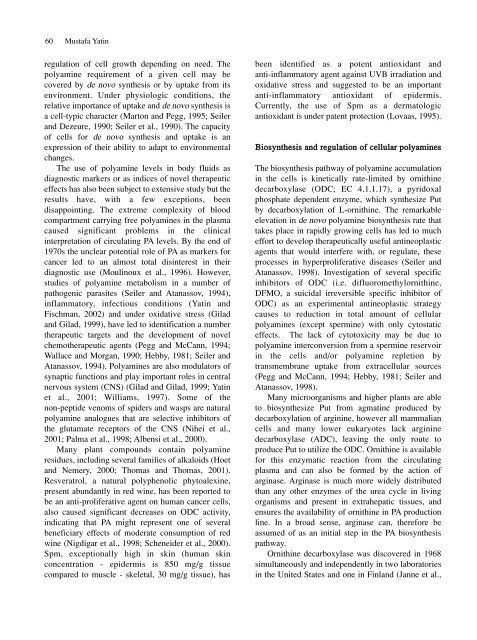Full Journal - Journal of Cell and Molecular Biology - Haliç Üniversitesi
Full Journal - Journal of Cell and Molecular Biology - Haliç Üniversitesi
Full Journal - Journal of Cell and Molecular Biology - Haliç Üniversitesi
You also want an ePaper? Increase the reach of your titles
YUMPU automatically turns print PDFs into web optimized ePapers that Google loves.
60 Mustafa Yatin<br />
regulation <strong>of</strong> cell growth depending on need. The<br />
polyamine requirement <strong>of</strong> a given cell may be<br />
covered by de novo synthesis or by uptake from its<br />
environment. Under physiologic conditions, the<br />
relative importance <strong>of</strong> uptake <strong>and</strong> de novo synthesis is<br />
a cell-typic character (Marton <strong>and</strong> Pegg, 1995; Seiler<br />
<strong>and</strong> Dezeure, 1990; Seiler et al., 1990). The capacity<br />
<strong>of</strong> cells for de novo synthesis <strong>and</strong> uptake is an<br />
expression <strong>of</strong> their ability to adapt to environmental<br />
changes.<br />
The use <strong>of</strong> polyamine levels in body fluids as<br />
diagnostic markers or as indices <strong>of</strong> novel therapeutic<br />
effects has also been subject to extensive study but the<br />
results have, with a few exceptions, been<br />
disappointing. The extreme complexity <strong>of</strong> blood<br />
compartment carrying free polyamines in the plasma<br />
caused significant problems in the clinical<br />
interpretation <strong>of</strong> circulating PA levels. By the end <strong>of</strong><br />
1970s the unclear potential role <strong>of</strong> PA as markers for<br />
cancer led to an almost total disinterest in their<br />
diagnostic use (Moulinoux et al., 1996). However,<br />
studies <strong>of</strong> polyamine metabolism in a number <strong>of</strong><br />
pathogenic parasites (Seiler <strong>and</strong> Atanassov, 1994),<br />
inflammatory, infectious conditions (Yatin <strong>and</strong><br />
Fischman, 2002) <strong>and</strong> under oxidative stress (Gilad<br />
<strong>and</strong> Gilad, 1999), have led to identification a number<br />
therapeutic targets <strong>and</strong> the development <strong>of</strong> novel<br />
chemotherapeutic agents (Pegg <strong>and</strong> McCann, 1994;<br />
Wallace <strong>and</strong> Morgan, 1990; Hebby, 1981; Seiler <strong>and</strong><br />
Atanassov, 1994). Polyamines are also modulators <strong>of</strong><br />
synaptic functions <strong>and</strong> play important roles in central<br />
nervous system (CNS) (Gilad <strong>and</strong> Gilad, 1999; Yatin<br />
et al., 2001; Williams, 1997). Some <strong>of</strong> the<br />
non-peptide venoms <strong>of</strong> spiders <strong>and</strong> wasps are natural<br />
polyamine analogues that are selective inhibitors <strong>of</strong><br />
the glutamate receptors <strong>of</strong> the CNS (Nihei et al.,<br />
2001; Palma et al., 1998; Albensi et al., 2000).<br />
Many plant compounds contain polyamine<br />
residues, including several families <strong>of</strong> alkaloids (Hoet<br />
<strong>and</strong> Nemery, 2000; Thomas <strong>and</strong> Thomas, 2001).<br />
Resveratrol, a natural polyphenolic phytoalexine,<br />
present abundantly in red wine, has been reported to<br />
be an anti-proliferative agent on human cancer cells,<br />
also caused significant decreases on ODC activity,<br />
indicating that PA might represent one <strong>of</strong> several<br />
beneficiary effects <strong>of</strong> moderate consumption <strong>of</strong> red<br />
wine (Nigdigar et al., 1998; Scheneider et al., 2000).<br />
Spm, exceptionally high in skin (human skin<br />
concentration - epidermis is 850 mg/g tissue<br />
compared to muscle - skeletal, 30 mg/g tissue), has<br />
been identified as a potent antioxidant <strong>and</strong><br />
anti-inflammatory agent against UVB irradiation <strong>and</strong><br />
oxidative stress <strong>and</strong> suggested to be an important<br />
anti-inflammatory antioxidant <strong>of</strong> epidermis.<br />
Currently, the use <strong>of</strong> Spm as a dermatologic<br />
antioxidant is under patent protection (Lovaas, 1995).<br />
Biosynthesis <strong>and</strong> regulation <strong>of</strong> cellular polyamines<br />
The biosynthesis pathway <strong>of</strong> polyamine accumulation<br />
in the cells is kinetically rate-limited by ornithine<br />
decarboxylase (ODC; EC 4.1.1.17), a pyridoxal<br />
phosphate dependent enzyme, which synthesize Put<br />
by decarboxylation <strong>of</strong> L-ornithine. The remarkable<br />
elevation in de novo polyamine biosynthesis rate that<br />
takes place in rapidly growing cells has led to much<br />
effort to develop therapeutically useful antineoplastic<br />
agents that would interfere with, or regulate, these<br />
processes in hyperproliferative diseases (Seiler <strong>and</strong><br />
Atanassov, 1998). Investigation <strong>of</strong> several specific<br />
inhibitors <strong>of</strong> ODC (i.e. difluoromethylornithine,<br />
DFMO, a suicidal irreversible specific inhibitor <strong>of</strong><br />
ODC) as an experimental antineoplastic strategy<br />
causes to reduction in total amount <strong>of</strong> cellular<br />
polyamines (except spermine) with only cytostatic<br />
effects. The lack <strong>of</strong> cytotoxicity may be due to<br />
polyamine interconversion from a spermine reservoir<br />
in the cells <strong>and</strong>/or polyamine repletion by<br />
transmembrane uptake from extracellular sources<br />
(Pegg <strong>and</strong> McCann, 1994; Hebby, 1981; Seiler <strong>and</strong><br />
Atanassov, 1998).<br />
Many microorganisms <strong>and</strong> higher plants are able<br />
to biosynthesize Put from agmatine produced by<br />
decarboxylation <strong>of</strong> arginine, however all mammalian<br />
cells <strong>and</strong> many lower eukaryotes lack arginine<br />
decarboxylase (ADC), leaving the only route to<br />
produce Put to utilize the ODC. Ornithine is available<br />
for this enzymatic reaction from the circulating<br />
plasma <strong>and</strong> can also be formed by the action <strong>of</strong><br />
arginase. Arginase is much more widely distributed<br />
than any other enzymes <strong>of</strong> the urea cycle in living<br />
organisms <strong>and</strong> present in extrahepatic tissues, <strong>and</strong><br />
ensures the availability <strong>of</strong> ornithine in PA production<br />
line. In a broad sense, arginase can, therefore be<br />
assumed <strong>of</strong> as an initial step in the PA biosynthesis<br />
pathway.<br />
Ornithine decarboxylase was discovered in 1968<br />
simultaneously <strong>and</strong> independently in two laboratories<br />
in the United States <strong>and</strong> one in Finl<strong>and</strong> (Janne et al.,

















